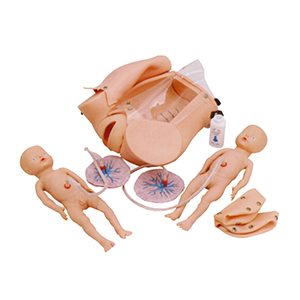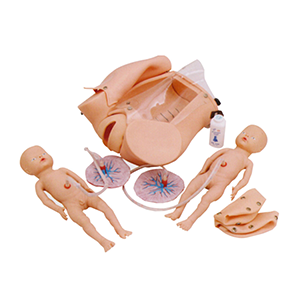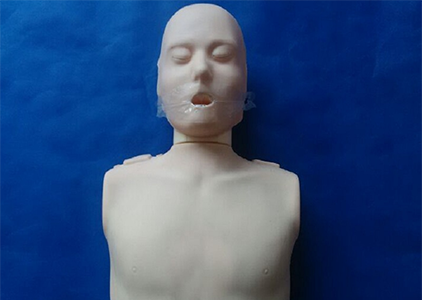
Childbirth is a complex and challenging physiological process that involves multiple stages and emergency response. In clinical practice, the ability of medical staff to deal with emergencies is very important. Industry experts believe that the childbirth mechanism teaching model, as an innovative teaching tool, can effectively improve learners' emergency handling ability, provide them with a more realistic and accurate simulation experience, and thus improve their emergency response speed and accuracy in practical work.

Teaching model of childbirth Mechanism
1. Enhanced real-time drills for emergency response
The delivery mechanism teaching model provides a highly simulated delivery environment that can simulate a variety of common emergency situations during childbirth, including sudden conditions such as misalignment of the fetus, umbilical cord around the neck, and postpartum bleeding. Through this simulation training, learners can repeatedly rehearse emergency procedures without patient risk. Industry data show that health care workers trained in simulated emergency response were able to respond more quickly to an emergency situation during childbirth than untrained workers, improving the speed and accuracy of emergency response by about 30% (source: Journal of Medical Education).
With the help of the birthing mechanism teaching model, students can not only learn basic birthing skills, but also practice through simulated emergency situations, so as to improve their emergency handling ability. For example, in the face of fetal misalignment or umbilical cord around the neck, learners can accurately judge and quickly take measures, such as timely adjustment of maternal position or surgical intervention.
2. Simulates multiple clinical complications and improves coping ability
The occurrence of clinical complications during childbirth is unpredictable. Whether the mother has abnormal contractions, or the fetus has hypoxia and other conditions, it needs to be handled quickly and correctly by the doctor and midwife. By simulating these complex clinical complications, the birthing mechanism teaching model provides learners with valuable practice opportunities. Experts point out that simulation training can help students accurately identify and respond to these complications, and this ability is often not fully practiced during the actual birth process.
For example, in the case of postpartum hemorrhage, the teaching model can simulate changes in the amount of blood lost and inform the learners of the outcome through real-time feedback. In this way, learners gain a clearer understanding of the impact of emergency interventions on birth outcomes while strengthening operational skills. The data showed that participants who were trained in the simulation were able to reduce the error rate in the management of postpartum bleeding and reduce the number of medical errors by about 20% in the actual work (source: International Journal of Nursing).
3. Improve communication and teamwork skills
During childbirth, the collaboration of the health care team is one of the key factors in responding to emergencies. The teaching model of childbirth mechanism can not only help learners improve their personal operation skills, but also strengthen the training of team cooperation. Through the simulation of a real childbirth scene, learners can conduct emergency response training together with their peers and mentors, and strengthen their communication and cooperation skills.
Industry experts point out that good teamwork can play a decisive role in the complex birth process. The birthing mechanism teaching model provides an ideal environment in which learners can maintain good communication with team members under pressure and jointly develop and implement emergency management plans. According to research data, participants who trained in teamwork improved their team communication efficiency by about 25% when dealing with complex obstetric events (Source: Medical Education and Teamwork Study).
4. Enhance operation accuracy and confidence
Emergency response requires not only rapid response, but also precise operation. The teaching model of childbirth mechanism provides learners with an environment in which they can accurately simulate various childbirth operations. Through the feedback mechanism of the model, learners can immediately know whether their actions are correct, so that they can constantly adjust and optimize their skills. This real-time feedback not only improves learners' accuracy, but also enhances their confidence.
Experts believe that the feedback system of the childbirth mechanism teaching model can help learners find their shortcomings in emergency handling and provide effective suggestions for improvement. For example, by simulating uterine contractions, learners can adjust their techniques and procedures in time to further improve the accuracy of the delivery process. This process of continuous improvement provides learners with the confidence to be more comfortable in the face of real cases.
5. Clinical significance: Reduce medical errors and improve patient safety
Emergency treatment during childbirth is directly related to the safety of mother and child. Simulation training enables learners to practice repeatedly in a risk-free environment and quickly apply the skills learned in real work, thus reducing the occurrence of medical errors. Research data show that simulation-trained midwives and health care workers can reduce medical errors in the face of emergencies during childbirth by approximately 15% and significantly improve maternal and newborn safety (source: Medical Simulators and Obstetric Care Study).
Through the teaching model of childbirth mechanism, learners not only learn how to deal with common childbirth complications, but also adapt to emergencies in the simulation training in advance, so as to make a more rapid and accurate response in the actual work. This training model has important clinical implications for improving patient safety and providing better protection for every expectant mother and newborn.
Conclusion
By simulating various emergency situations, the delivery mechanism teaching model provides comprehensive emergency handling training for learners, and significantly improves their emergency response ability, operational accuracy and teamwork ability. Industry experts agree that this simulation training not only improves learners' clinical skills, but also effectively reduces medical errors and improves patient safety in the real world. With the continuous progress of medical education, the teaching model of childbirth mechanism will continue to play an important role in improving the emergency response capacity and ensuring the safety of mother and child.







Sophie Asveld
February 14, 2019
Email is a crucial channel in any marketing mix, and never has this been truer than for today’s entrepreneur. Curious what to say.
Sophie Asveld
February 14, 2019
Email is a crucial channel in any marketing mix, and never has this been truer than for today’s entrepreneur. Curious what to say.